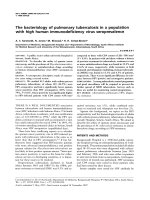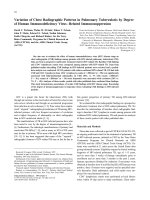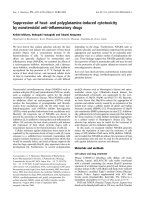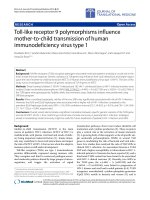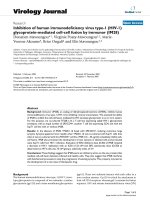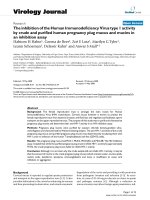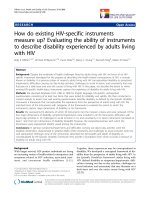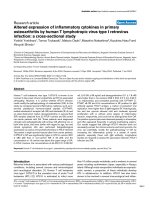Mechanisms of resistance to antibodydependent cell-mediated cytotoxicity by human immunodeficiency virus
Bạn đang xem bản rút gọn của tài liệu. Xem và tải ngay bản đầy đủ của tài liệu tại đây (17.48 MB, 115 trang )
Mechanisms of resistance to antibodydependent cell-mediated cytotoxicity by
human immunodeficiency virus
Resistenzmechanismen des Humanen
Immundefizienz-Virus gegen
antikörperabhängige zellvermittelte Zytotoxizität
Der Naturwissenschaftlichen Fakultät
der Friedrich-Alexander-Universität
Erlangen-Nürnberg
zur
Erlangung des Doktorgrades Dr. rer. nat.
vorgelegt von
Benjamin von Bredow
aus Schweinfurt
Als Dissertation genehmigt
von der Naturwissenschaftlichen Fakultät
der Friedrich-Alexander-Universität Erlangen-Nürnberg
Tag der mündlichen Prüfung: 20.06.2017
Vorsitzender des Promotionsorgans: Prof. Dr. Georg Kreimer
Gutachter: Prof. Dr. Thomas Winkler
Dr. David Evans, PhD
Contents
Zusammenfassung ..................................................................................................................... 1
Abstract ...................................................................................................................................... 3
Introduction ............................................................................................................................... 4
Public Health Considerations ................................................................................................. 4
The AIDS pandemic ............................................................................................................ 4
Transmission ...................................................................................................................... 4
Clinical presentation and diagnostics ................................................................................ 5
Treatment .......................................................................................................................... 5
Basic Biology of HIV................................................................................................................ 6
Classification and origin ..................................................................................................... 6
Genome organization and virion structure........................................................................ 7
Viral replication .................................................................................................................. 7
The immune response to HIV ................................................................................................ 9
Innate immunity................................................................................................................. 9
Cellular immunity ............................................................................................................. 10
Humoral immunity ........................................................................................................... 11
Discussion ................................................................................................................................14
Improving antibody-based HIV therapy............................................................................... 14
Combination antibody therapy ........................................................................................ 14
Elimination of infected cells by Fc-dependent antibody functions ................................. 15
Targeting the viral reservoir............................................................................................. 15
Fc-dependent antibody functions in cancer .................................................................... 16
Antigen density modulates antibody Fc functions .............................................................. 16
Env internalization ........................................................................................................... 17
Tetherin downmodulation ............................................................................................... 19
Env resistance to antibody recognition ............................................................................... 20
The Env glycan shield ....................................................................................................... 21
Conformational epitope masking .................................................................................... 22
Laboratory-adapted HIV isolates ..................................................................................... 24
Conclusions ..............................................................................................................................26
References ...............................................................................................................................29
Abbreviations ...........................................................................................................................58
Author contributions ...............................................................................................................60
Publications ..............................................................................................................................64
Zusammenfassung
Zusammenfassung
Antikörper sind ein wesentlicher Bestandteil der Immunantwort gegen HIV-Infektion. Viele
Antikörper wurden identifiziert, welche ein breites Spektrum an HIV-Isolaten effizient neutralisieren.
Experimente mit passivem Antikörpertransfer in Tiermodellen haben das therapeutische Potenzial
dieser Antikörper gezeigt. Es wird immer offensichtlicher, dass Fc-vermittelte Funktionen,
einschließlich antikörperabhängiger zellvermittelter Zytotoxizität (engl. Antibody-dependent cellmediated cytotoxicity, ADCC), zur Schutzwirkung dieser Antikörper beitragen. Trotzdem kann die
humorale Immunantwort HIV-Replikation in infizierten Personen nicht endgültig eindämmen, da HIV
mehrere unterschiedliche Resistenzmechanismen gegen antivirale Antikörper im Allgemeinen und
ADCC im Besonderen besitzt.
Diese Arbeit zeigt, dass HIV die Beseitigung infizierter Zellen durch ADCC mittels Modulation
der Menge von Envelope-Glykoprotein (Env) auf der Zelloberfläche verhindert. Ein in hohem Maße
konserviertes Clathrin-abhängiges Endozytose-Motiv in der membranangrenzenden Region von gp41
schützt HIV-infizierte Zellen durch effiziente Internalisierung von Env vor ADCC. Darüber hinaus
reduziert Antagonismus des zellulären Restriktionsfaktors Tetherin durch das virale Protein U (Vpu)
die Anfälligkeit der infizierten Zellen gegenüber der Lyse durch NK Zellen. Hierbei wird die Anzahl der
Virionen verringert, die durch Tetherin physisch an die Zelloberfläche gebunden sind, was zur
Reduzierung der Menge an Envelope-Glykoprotein an der Plasmamembran führt. Die Verringerung
des Env-Niveaus an der Zelloberfläche durch diese Mechanismen ist kumulativ und korreliert direkt
mit reduzierter Anfälligkeit für antikörpervermittelte Lyse. Dies weist darauf hin, dass die
Antigenmenge auf HIV-infizierten Zellen ADCC entscheidend beeinflusst.
Das
Envelope-Glykoprotein
selbst
ist
zudem
von
Natur
aus
resistent
gegen
Antikörperbindung. Durch Vergleich von Neutralisation und ADCC-Aktivität von monoklonalen HIV-1spezifischen Antikörpern gegen unterschiedliche Epitope auf Env wurden sowohl Ähnlichkeiten als
auch Unterschiede zwischen diesen Funktionen etabliert. Antikörper, welche die Lyse von mit
primären Virusisolaten infizierten Zellen anleiteten, reduzierten ebenfalls die virale Infektiosität.
Jedoch vermittelten nicht alle neutralisierenden Antikörper ADCC. Desweiteren vermittelten
mehrere nicht neutralisierende Antikörper NK-Zellabhängige Lyse von Zellen, welche mit dem
laborangepassten Isolat HIV-1NL4-3 infiziert waren. Dies ist wahrscheinlich die Folge von unnatürlichen
Env-Konformationen auf der Zelloberfläche.
Die hier vorgestellten Resultate zeigen eine Mehrzahl von Methoden auf, mit denen HIV-1
infizierte Zellen vor Erkennung durch Antikörper und NK-zellabhängiger Lyse schützt. Diese
Ergebnisse deuten darauf hin, das ADCC Selektionsdruck ausübt. Sie könnten weiterhin dabei helfen,
1
Zusammenfassung
Bemühungen zu leiten, um Fc-abhängige Antikörperfunktionen für antiretrovirale Therapie nutzbar
zu machen.
2
Abstract
Abstract
Antibodies are an essential part of the immune response to HIV infection. Many antibodies
that potently neutralize a broad spectrum of HIV isolates have been identified, and passive transfer
experiments in animal models have shown their therapeutic potential. It is becoming increasingly
clear that Fc-mediated functions, including antibody-dependent cell-mediated cytotoxicity (ADCC),
contribute to the protective effects of these antibodies. However, HIV ultimately evades the
humoral immune response using a number of different mechanisms of resistance to antiviral
antibodies in general and ADCC specifically.
This work shows that HIV prevents the elimination of infected cells by ADCC by modulating
cell surface levels of envelope glycoprotein (Env). A highly conserved clathrin-dependent endocytosis
motif in the membrane-proximal region of gp41 protects HIV-infected cells from ADCC by mediating
the efficient internalization of Env. Furthermore, antagonism of the cellular restriction factor
tetherin by the viral protein U (Vpu) reduces susceptibility of infected cells to NK cell lysis by
reducing the number of virions physically linked to the cell surface by tetherin, thus lowering the
amount of envelope glycoprotein present at the plasma membrane. The reduction of cell surface
Env levels by these mechanisms is cumulative and directly correlates with an increase in resistance
to antibody-mediated lysis, indicating that antigen levels on cells infected with HIV are an important
determinant of ADCC activity.
The envelope glycoprotein itself is also inherently resistant to antibody binding. Through
comparison of neutralization and ADCC activity of monoclonal HIV-1-specific antibodies targeting
diverse epitopes on Env, similarities and differences between these functions were established.
Whereas antibodies that direct the lysis of cells infected with primary virus isolates also block viral
infectivity, not all neutralizing antibodies mediate ADCC. In contrast, several non-neutralizing
antibodies mediate NK cell lysis of cells infected with the laboratory-adapted isolate HIV-1NL4-3, likely
as a result of non-native conformations of Env on the cell surface.
Together, the findings presented here reveal a variety of methods by which HIV-1 protects
infected cells from antibody recognition and NK cell-dependent lysis. These results suggest the
presence of selective pressure exerted by ADCC and may help guide efforts to harness Fc-dependent
antibody functions for antiretroviral therapy.
3
Introduction
Public Health Considerations
Introduction
Public Health Considerations
The AIDS pandemic
The World Health Organization (WHO) estimates that over 36 million people are currently
infected with human immunodeficiency virus (HIV) (1, 2), the causative agent of acquired
immunodeficiency syndrome (AIDS). Despite 35 years of research and concerted international
efforts to end the AIDS pandemic, the number of new infections is declining at a slow rate (1, 3).
Presently, approximately 2.1 million people globally are newly infected with HIV every year, a
reduction of circa 12.5% over the last decade (1, 2). Although mortality has decreased significantly
thanks to increased awareness and treatment availability, the WHO reported an estimated 1.1
million AIDS-related deaths in 2015 world-wide, over 800,000 of which occurred in Africa alone (1,
2). With over 25 million HIV-infected individuals, Africa is the region most affected by the pandemic
(1, 2). However, although the prevalence in areas with easily accessible treatment and wide-reaching
awareness and prevention campaigns, such as North America and Western Europe, remains below
1% (1, 4), over 10 million people outside Africa are currently infected with HIV (1, 2). HIV/AIDS
therefore remains a global public health concern.
Transmission
Since approximately 85% of new infections occur through either vaginal, anal, or oral sexual
contact (5, 6), HIV is principally a sexually transmitted infection. However, exposure through
percutaneous routes can also lead to HIV infection (5). Transmission through contaminated blood
products has been drastically reduced in developed countries through the widespread adoption of
screening techniques for HIV-specific antibodies and viral RNA (7, 8). However, these detection
methods are not universally available (7, 9), and the chance of infection after transfusion of a
contaminated blood product is estimated at 90% (10). Contaminated blood products thus remain a
major risk factor in certain regions. Similarly, needle sharing among intravenous drug users
represents another key route of infection (1, 2, 5, 11). Finally, there is significant risk of HIV
transmission from infected mothers to their children (5, 12, 13). Mother-to-child transmission can
occur intrauterine through the placenta (12–16), exposure to maternal blood and genital secretions
during birth (12, 13), or breast milk from an HIV-infected mother (12, 13, 17–19).
4
Introduction
Public Health Considerations
Clinical presentation and diagnostics
The earliest events leading from exposure to HIV infection are poorly understood. Animal
studies and experiments in human cervical explants and tissue culture investigating vaginal
transmission suggest that after traversing mucosa of the female reproductive tract within the first
hours post-exposure, HIV expands locally in CD4 T cells, Langerhans’ cells and dendritic cells (DCs)
before disseminating through the lymphoid system (6, 20–27). In both humans and macaques, the
infection initially spreads through the gut-associated lymphoid tissue (GALT) before becoming
systemic (6, 20, 28–33). Throughout the first weeks of infection, rapid viral expansion leads to rising
plasma viral loads and the depletion of CD4 T cells, until peak viremia is reached approximately 3-4
weeks post infection (6, 34, 35). During this period, patients may present with acute retroviral
syndrome, most commonly displaying flu-like symptoms such as fever and fatigue, as well as
additional indicators such as rashes or ulcers (36–39). After an ‘eclipse phase’ of undetectable virus
loads lasting 7-10 days, viral RNA can be detected using highly sensitive nucleic acid amplification
techniques (6, 34, 35). At approximately 2 weeks post-infection, the viral p24 antigen is detectable in
plasma, and the first immunoglobulin M (IgM) antibodies generally appear within the third week (6,
34, 35). The acute HIV infection (AHI) ends when the antibody response becomes detectable, plasma
viral load begins to decline and CD4 T cell counts recover (6, 34, 35). Approximately 6-12 weeks after
exposure, the plasma viral load stabilizes, marking the transition from early HIV infection (EHI) to the
chronic phase (6, 34, 35, 40). Throughout chronic HIV infection, CD4 T cells are steadily depleted,
albeit at a much slower rate than during AHI (6, 34, 35). The duration of this phase can be estimated
from the set-point viral load and the baseline CD4 T cell count, and can vary anywhere from months
to decades (41–44). During chronic HIV infection, patients are generally asymptomatic, but may
develop symptoms indicative of a defect in the cellular immune system, such as oral thrush, Herpes
zoster or peripheral neuropathy (45, 46). The final stage of an HIV infection is AIDS, which can be
defined either as a CD4 T-cell count below 200/µl (45, 46) or the presentation of specific symptoms
classified as AIDS-defining illness (45–47). These symptoms include various types of cancer, outbreak
of latent herpes viruses, and opportunistic infections (45–47). If the HIV infection remains untreated,
death typically occurs within 2-4 years after the first signs of AIDS-related disease, whereas with
treatment, the majority of patients survive for >10 years after the onset of AIDS (48).
Treatment
Although a true cure for HIV infection remains elusive, modern antiretroviral therapy (ART)
allows patients to lead an essentially normal life, and life expectancies for HIV-infected individuals
5
Introduction
Basic Biology of HIV
receiving ART approach those of the uninfected population (49). A variety of drugs interfering with
the viral life cycle at different points are now available (50–52). Entry inhibitors prevent viral
attachment to and entry into the host cell, either by sterically hindering receptor or co-receptor
binding or by blocking conformational changes required for membrane fusion (53–55). Nucleoside
and nucleotide reverse transcriptase inhibitors (NRTIs) are deoxynucleoside triphosphate (dNTP)
analogs that, due to their lack of a 3’-hydroxyl group, cause premature termination when they are
incorporated during reverse transcription (56, 57). Non-nucleoside reverse transcriptase inhibitors
(NNRTIs), on the other hand, allosterically bind to the reverse transcriptase (RT), introducing
structural changes in RT that inhibit its catalytic activity (57, 58). Integrase inhibitors interfere with
the strand transfer step during the integration of viral DNA into the host cell genome (59). HIV
protease inhibitors do not prevent HIV infection directly; instead, they render progeny virions noninfectious by inhibiting the proteolytic cleavage of Gag and Gag-Pol during maturation (60). Agents
with different mechanisms of action are typically employed simultaneously, thus increasing
treatment efficacy and reducing the risk of HIV acquiring resistance to any individual therapeutic
agent (52, 61, 62). Although the virus does eventually evolve drug resistance (63), due to this use of
combination ART (cART) and the different classes of antiretroviral drugs available, estimates suggest
a median effective treatment length of 45 years (64).
Basic Biology of HIV
Classification and origin
HIV belongs to the genus Lentivirus in the family Retroviridae (65, 66). Lentiviruses infect a
variety of different species, including cats (feline immunodeficiency virus [FIV]), cattle (bovine
immunodeficiency virus [BIV]), as well as monkeys and apes (simian immunodeficiency virus [SIV]).
Evolutionary evidence suggests that HIV is the result of zoonotic transmission of SIV to humans (67–
76). There are two types of HIV with distinct genomes which infect humans, HIV-1 and HIV-2. Each
can be further subdivided into groups, which are thought to represent individual transmission
events. HIV-1 group M, the pandemic form of HIV-1, and group N, of which only a handful of cases
have been identified, are almost certainly derived from SIV infecting chimpanzees in southern
Cameroon (SIVcpzPtt) (67–69). There is some evidence suggesting HIV-1 group P, of which only two
cases have been reported, and group O, which represents less than 1% of HIV infections, originated
from SIV found in western lowland gorillas (SIVgor) (70, 71). On the other hand, all eight lineages of
HIV-2, groups A-H, are the result of cross-species transmission from sooty mangabeys (SIVsmm) to
humans (72–76).
6
Introduction
Basic Biology of HIV
Genome organization and virion structure
Fig. 1. Landmarks of the HIV-1 genome, HXB2 (K03455). Open reading frames are shown as rectangles. The gene start,
indicated by the small number in the upper left corner of each rectangle, normally records the position of the a in the ATG
start codon for that gene, while the number in the lower right records the last position of the stop codon. For pol, the start
is taken to be the first T in the sequence TTTTTTAG, which forms part of the stem loop that potentiates ribosomal slippage
on the RNA and a resulting -1 frameshift and the translation of the Gag-Pol polyprotein. The tat and rev spliced exons are
shown as shaded rectangles. In HXB2, *5772 marks position of frameshift in the vpr gene caused by an "extra" T relative to
most other subtype B viruses; !6062 indicates a defective ACG start codon in vpu; †8424, and †9168 mark premature stop
codons in tat and nef. See Korber et al., Numbering Positions in HIV Relative to HXB2CG, in the database
compendium, Human Retroviruses and AIDS, 1998.
Figure and legend from (82). Reproduced with permission from the Los Alamos National Laboratory.
HIV, like other retroviruses, is an enveloped positive-strand RNA virus (77–80). The viral RNA
genome encodes nine genes flanked by two partial long terminal repeat (LTR) sequences (Fig. 1) (81,
82). These repeat sequences are essential for reverse transcription, which also produces the
complete LTRs that play an essential part in gene expression (83, 84). The capsid core consists of
approximately 1500 molecules of the capsid (CA) protein (85). It contains two copies of the viral RNA
genome bound to nucleocapsid (NC) (86–88), and is enveloped in a lipid bilayer originating from the
host cell plasma membrane (89). Embedded in this membrane are approximately 14 envelope (Env)
glycoprotein trimers (90), with each monomer containing a surface (SU) component, gp120, and a
transmembrane (TM) subunit, gp41 (91–93). Matrix (MA) proteins line the inside of the viral
membrane (94, 95); the number of MA molecules differs by virion size, but is estimated to be 5000
copies in a virion of the average 145 nm diameter (96).
Viral replication
The major target of HIV infection are cells carrying the CD4 surface receptor (97, 98).
Additionally, a chemokine receptor, typically CCR5 or CXCR4, is required as a co-receptor for viral
entry (99, 100). As such, the majority of HIV replication occurs in CD4 T-cells (101, 102), although
other cell types, such as macrophages and dendritic cells, play a role in HIV propagation (103–105).
Once bound to CD4 on the target cell surface, HIV Env undergoes a conformational change forming
7
Introduction
Basic Biology of HIV
the co-receptor binding site (CoRBS) (106–110). Upon engagement of the cellular co-receptor, the
fusion peptide of gp41 is embedded in the membrane of the target cell, and C-terminal and Nterminal heptad repeat regions in gp41 interact to form a six-helix bundle (111–113). This brings the
viral envelope into close proximity to the cell membrane, facilitating membrane fusion and release
of the viral core into the cytoplasm of the target cell.
Upon entry, the viral RNA genome is reverse transcribed into a double-stranded viral DNA
(vDNA) intermediate by the viral RT (77–80). Late in the reverse transcription process, a preintegration complex (PIC) is formed by recruiting host cellular and viral proteins, including the viral
integrase (IN), to the vDNA (114–118), and is imported into the nucleus via the nuclear pore complex
(NPC). At this point, the majority of the CA proteins comprising the viral core have been shed,
although the exact timing of this uncoating is still the subject of debate (117, 119). The vDNA is then
integrated into the genome of the host cell by IN, forming the provirus from which the host
transcription machinery produces viral genomic and messenger RNA (gRNA and mRNA, respectively)
(120–122).
Viral gene expression is dependent on the viral trans-activator of transcription (Tat) (123–
125), and nuclear export of unspliced and partially spliced viral RNA is facilitated by the regulator of
virion expression (Rev) protein (126–128). In addition to the group-specific antigen (Gag) and Gagpolymerase (Gag-Pol) precursor proteins, which are essential for the formation of infectious virions
(95, 129, 130), several accessory proteins are also expressed (131–133). These include viral
infectivity factor (Vif) (134), viral protein R (Vpr) (135, 136), and negative factor (Nef) (137), as well
as viral protein U (Vpu) in HIV-1 (138) and viral protein X (Vpx) in HIV-2 and SIV (136). Although these
accessory proteins are not essential for replication, they promote viral replication and contribute to
immune evasion (131–133, 139). The majority of viral proteins are produced in the cytosol.
However, Vpu and the Env precursor, gp160, are translated at the endoplasmic reticulum, where
gp160 is also heavily glycosylated (140, 141). Before Env is integrated into the cell membrane
through the secretory pathway, the oligosaccharide side chains are modified in the trans-golgi
network (TGN), and gp160 is processed into the gp41 and gp120 subunits which comprise the
fusogenically active Env trimer (140, 141). Gag, which encompasses MA, CA, NC and p6, associates
with viral gRNA, multimerizes and traffics to the cell membrane, initiating the assembly of progeny
virions (95, 130). A number of Gag-Pol proteins are also incorporated, which are generated by a
programmed frame shift during translation of the gag-pol mRNA which occurs about 5% of the time
and appends PR, RT and IN to the C-terminus of Gag (142). Env is recruited to the assembly site, and
the cellular ESCRT machinery is used to facilitate budding of immature virions (130, 143). Finally, Gag
8
Introduction
The immune response to HIV
and Gag-Pol are cleaved by PR, producing active forms of PR, RT and IN and allowing CA to assemble
into the capsid core, resulting in a mature, infectious virion (94, 130).
The immune response to HIV
Innate immunity
The innate immune system provides the first response to any infection. Pathogen-associated
molecular patterns (PAMPs), which are non-specific markers of infection such as bacterial
lipopolysaccharides or viral DNA or RNA within an infected cell, are recognized by cellular pattern
recognition receptors (PRRs), allowing for a rapid immune reaction (144). If HIV transmission occurs
through a mucosal surface, toll-like receptor 2 (TLR2) and TLR4 on the surface of mucosal epithelial
cells can recognize gp120, triggering the production of proinflammatory cytokines and chemokines
(145, 146). In HIV-infected cells, viral gRNA and RT products in the cytosol are recognized by PRRs
including interferon inducible protein 16 (IFI16), cyclic GMP-AMP synthase (cGAS), and RIG-I (146–
151). Viral gRNA in endosomal compartments triggers signaling through the PRRs TLR7 and TLR8
(152).
PRR signaling upon detection of HIV results in a variety of antiviral responses. Production of
proinflammatory cytokines and chemokines leads to the recruitment and activation of immune cells
(144, 146, 153, 154). Although this process is critical for an effective immune response, the cells
recruited to the site of infection include activated CD4+ cells susceptible to infection by HIV, which
could aid early virus replication (155). Furthermore, PAMP sensing can cause inflammatory death (or
pyroptosis) of infected cells (156). It has been suggested that IFI16 contributes to the depletion of
CD4+ T-cells by causing pyroptosis of bystander cells after sensing RT products of abortive infection
(157). Finally, PRR signaling initiates an interferon response, leading to the expression of a multitude
of interferon-stimulated genes (ISGs) with potent antiviral activities (144, 146–148, 158).
Restriction factors are thought to be among the most important ISGs in the context of HIV
infection. Restriction factors suppress virus replication in a variety of ways, necessitating the evasion
of their antiviral functions for efficient HIV replication. Several different restriction factors have been
identified to date, each with a corresponding antagonist in HIV (132, 133). The apolipoprotein B
mRNA-editing enzyme catalytic polypeptide-like 3 (APOBEC3) family of proteins is co-packaged into
nascent virions and causes hypermutation of the proviral DNA in the newly infected target cell,
rendering the infection nonproductive (159–161). APOBEC3 proteins are efficiently targeted for
proteosomal degradation by the Vif accessory protein (132–134, 162). Tripartite-motif-containing 5α
9
Introduction
The immune response to HIV
(TRIM5α) interferes with viral replication shortly after viral entry by a mechanism involving direct
interaction between TRIM5α and CA, the details of which are not fully understood (163, 164).
However, TRIM5α proteins do not typically restrict retroviruses native to the host species; for
example, human TRIM5α does not block HIV-1 infection efficiently, whereas rhesus macaque
TRIM5α does (165–168). In non-dividing cells, sterile alpha motif (SAM)-domain- and HD-domaincontaining protein 1 (SAMHD1) causes a partial block in replication (169–171). It is generally
accepted that the ability of SAMHD1 to dephosphorylate dNTPs is responsible for this block,
whereas the theory that its RNAse activity may play a role has been largely discredited (169, 172,
173). Vpx, which is found in HIV-2 and SIV, but not HIV-1, mediates the degradation of SAMHD1
(174–177). Although this calls into question the importance of SAMHD1 in HIV-1 infection, Vpx
enhances HIV-1 replication in non-dividing cells when co-packaged into HIV-1 virions (178, 179).
Finally, tetherin, also known as bone marrow stromal cell antigen 2 (BST-2) or CD317, prevents the
release of nascent virions from an infected cell by physically linking the viral and cell plasma
membranes (180, 181). Whereas tetherin antagonism is a function of Nef in most SIV strains (182–
184), an ancestral deletion in human tetherin prevents Nef-mediated downregulation of tetherin in
human cells (183, 184). HIV-1 therefore removes tetherin from sites of viral assembly using its Vpu
protein (180, 181), whereas this function was acquired by Env in HIV-2 (185, 186).
Another aspect of the innate immune response to HIV are interactions between class I major
histocompatibility complex (MHC-I) molecules on the surface of infected cells and killer-cell
immunoglobulin-like receptors (KIRs) mainly on the surface of natural killer (NK) cells (187). NK cell
activation and lytic activity are controlled by a balance of activating and inhibitory receptors on the
cell surface (188). Because healthy cells are protected from NK cell lysis by binding of inhibitory KIRs
to MHC-I, the loss of MHC-I expression can lead to NK cell activation (189). Furthermore, a multitude
of activating receptors, including activating KIRs as well as receptors for the fragment, crystallizable
(Fc) region of antibodies (Fc receptors, FcRs), can cause NK cells to lyse target cells by releasing
perforin- and granzyme-containing granules (188).
Cellular immunity
The CD8 T-cell response to HIV is a critical component of antiretroviral immunity (190).
Animal experiments have shown that CD8 depletion leads to a significant increase in virus load (191–
193), and certain alleles of genes encoding MHC-I are enriched in animals that do not progress to
AIDS for extended periods of time (194, 195). Similarly, specific human leukocyte antigen (HLA)
alleles are more common among human long-term non-progressors (196–200). There are a number
10
Introduction
The immune response to HIV
of mechanisms by which HIV-1 protects infected cells from cytotoxic CD8 T-cells. Maybe most
importantly, the accessory protein Nef efficiently downmodulates MHC-I, thereby limiting the
number of viral peptides presented on the surface of infected cells and protecting them from lysis by
CD8 T-cells (201, 202). Additionally, HIV will acquire escape mutations in epitopes presented on
MHC-I and targeted by CD8 T-cells, preferentially in anchor residues (203–205). However, in some
cases, these escape mutations may be deleterious to viral fitness (206).
Humoral immunity
The ability to induce a broad and potent antibody response is considered essential for
vaccination strategies aimed at preventing the transmission of HIV (207, 208). Antibodies could play
a role in stopping the virus from establishing an infection and in controlling viremia, both by blocking
viral infectivity and eliminating infected cells. A better understanding of these antiviral functions of
antibodies that may contribute to protective effects could help guide efforts to develop novel
vaccines or antibody-based therapeutics.
Neutralization
Neutralization is arguably the most immediate way by which antibodies combat HIV
infection. To productively infect a target cell, the virus must first recognize its receptors via its
envelope glycoprotein and successfully fuse with the cellular plasma membrane. Neutralizing
antibodies interfere with virus entry, thus preventing the spread of infection. All HIV-1-specific
neutralizing antibodies bind to Env (209, 210), but may block viral infectivity through different
mechanisms, such as occluding the receptor or co-receptor binding site, or by preventing the
conformational changes in Env required for membrane fusion (reviewed in (211)). Nonetheless,
neutralization fails to contain HIV infection for a variety of reasons. The high mutation rate of HIV
causes the virus to rapidly evolve to escape any antibody response mounted by the host (212, 213).
Furthermore, functional HIV envelope glycoprotein trimers on virions exhibit a tightly closed
conformation and are heavily glycosylated. This efficiently shields the functionally required,
conserved epitopes on Env, such as the CD4 binding site, from antibody recognition (108, 213–217).
The sequence diversity of circulating HIV isolates, together with features of Env conferring resistance
to antibody binding, significantly complicate the development of broad and efficient antibody-based
vaccines and treatments (207, 208).
11
Introduction
The immune response to HIV
Over years of infection, a small
minority (< 1%) of HIV-1-infected patients
develop antibodies with potent neutralizing
activity against a broad spectrum of HIV-1
isolates (218–221). Concerted efforts have
resulted in the identification, isolation and
characterization of increasing numbers of
these
broadly
neutralizing
antibodies
(bNAbs), some of which display remarkable
potency against up to 95% of tested HIV
isolates (Reviewed in (209, 210, 222)). These
antibodies are typically the product of
unusually
high
levels
of
somatic
hypermutation, and in many cases contain
an
extended
complementary
(CDR3)
(209,
heavy
chain
determining
223–226).
By
(HC)
region
3
Fig. 2. Structure and Antibody Recognition of the HIV
Envelope Spike. The model is adapted from a cryo-electron
tomographic structure of the HIV trimer. The crystal structure
of the b12-bound monomeric gp120 core (red) has been fitted
into the density map. Glycans are shown in purple. The CD4
binding site is shown in yellow. The approximate locations of
the epitopes targeted by existing bNAbs are indicated with
arrows, and the number of bNAbs targeting each epitope is
shown in red boxes. A small selection of bNAbs targeting each
epitope is included.
Adapted from (386), with permission from Elsevier.
targeting
conserved structures on Env, such as the CD4 binding site (CD4bs), co-receptor binding site (CoRBS),
the membrane-proximal external region (MPER) of gp41 and glycan-dependent epitopes in the
variable regions of gp120, bNAbs can block viral infectivity of highly diverse HIV strains (209, 210,
222).
Although viral escape renders these bNAbs inefficient in the individuals from which they
were isolated (225, 227), they can confer protective effects when provided in trans. Passive transfer
of bNAbs has provided sterilizing immunity from recombinant simian-human immunodeficiency
viruses (SHIVs) expressing HIV-1 Env in rhesus macaques (228, 229), and reduced viral loads, in some
cases to undetectable levels, in HIV-1-infected humanized mice and SHIV-infected rhesus macaques
(230–232). Vectored immunoprophylaxis, the transfer of bNAb-encoding genes into host muscle
cells using viral vectors, blocked HIV-1 transmission, reduced virus replication, and protected CD4 Tcells in humanized mice (233, 234). More recently, passive transfer experiments in HIV-1-infected
humans showed a significant decrease in viral loads in individuals treated with bNAbs (235, 236).
Antibodies therefore have the potential to be a valuable tool in combating HIV infection.
12
Introduction
The immune response to HIV
Fc-mediated antibody functions
Besides targeting the virion itself, antibodies can also mark infected cells for clearance by
the immune system (237). After binding to viral antigens on the surface of an infected cell, the Fc
region of antibodies can be recognized by Fc receptors (FcRs), which are expressed on a variety of
effector cells. For example, monocytes and dendritic cells can eliminate opsonized cells via antibodydependent cell-mediated phagocytosis (ADCP), whereas NK cells release toxic granules containing
perforin and granzyme in a process known as antibody-dependent cell-mediated cytotoxicity (ADCC)
(238–240). Furthermore, the antibody Fc region can initiate the complement cascade, ultimately
leading to virus or cell lysis (241). These effector functions likely help contain the spread of infection
by clearing infected cells, thus limiting the production of progeny virions.
Numerous studies suggest that functions mediated by FcγR, the FcR for isotype G
immunoglobulins (IgG), are an important component of the protective effects of antibodies in an HIV
infection (237–239). In the RV144 trial, IgG binding to Env was inversely correlated with risk of HIV
infection, whereas IgA binding directly correlated with risk (242). Additionally, IgG3 responses were
more frequent in the partially successful RV144 trial compared to the unsuccessful Vax003 trial and
were associated with reduced risk of HIV acquisition, suggesting that the Fc regions contributes to
the antiviral activity of antibodies (243, 244). Similarly, increased FcγR-mediated effector functions
were associated with improved outcomes in several non-human primate studies (245–248). In
mouse models, the importance of FcγR-dependent antibody functions was established using both Fcand FcγR-variants (249, 250). Passive transfer experiments in rhesus macaques using an Fc variant of
the bNAb b12 with reduced affinity for FcγR suggested that Fc-FcγR-interactions contribute to the
protection mediated by these antibodies (251, 252). It therefore seems likely that antibody effector
functions play a role in antibody-mediated protection against HIV.
Some lines of evidence indicate that ADCC may be an especially important part of the
humoral immune response to HIV. A number of studies have found correspondence between ADCC
titers in patients and correlates of protection, such as delayed disease progression and lower viral
titers, and associate ADCC activity with immune pressure (reviewed in (237)). ADCC activity also
correlated with lower risk of infection in RV144 participants with low IgA titers (242). These results
are mirrored by a number of vaccine studies in non-human primates, where vaccine-induced ADCC
activity predicted a lower chance of SIV acquisition and reduced viral loads if an infection was
established (247, 253–256). It also appears that ADCC may help prevent or improve the outcome of
mother-to-child transmission (257–260). Together, these results suggest that ADCC-mediating
antibodies can help contain HIV infections.
13
Discussion
Improving antibody-based HIV therapy
Discussion
Despite the wealth of research describing the protective effects of antibodies in the context
of HIV infection, no effective vaccination or immunotherapy strategies have emerged to date.
Whereas the passive transfer of bNAbs has been shown to provide protective immunity in animal
studies, it has not been shown that these antibodies can similarly prevent HIV-1 transmission in
humans. Furthermore, it is currently not feasible to perpetually provide these bNAbs in trans to at
risk individuals. Vaccination strategies eliciting these types of broad and potent humoral immune
responses are unavailable at this time, thus limiting the use of antibodies to treatment, not
prevention, of HIV infection. Although antibodies administered post-infection have yielded
promising results in both animals and humans, the virus ultimately escapes even the most potent of
known antibodies. For immunotherapy to be considered a viable treatment option, it is therefore
essential to optimize the antiviral activity of antibodies for therapeutic use.
Improving antibody-based HIV therapy
Combination antibody therapy
There are multiple approaches that could be used to enhance antibody-based treatments of
HIV infection. Similar to cART, multiple antibodies used in combination may reduce the chance of
viral escape. By targeting different epitopes on Env, this strategy would force the virus to acquire
multiple resistance mutants simultaneously to be able to spread, thus likely increasing the time until
viable escape mutants arise. Antibody combinations have been used successfully in animal models; a
combination of purified immunoglobulin isolated from HIV-infected individuals (HIVIG) with the
antibodies 2F5 and 2G12 was significantly more efficient at protecting rhesus macaques from SHIV
challenge than either 2F5 and 2G12 or 2G12 alone (261). Additionally, HIV-infected humanized mice
treated with a combination of three monoclonal HIV-1 Env-specific antibodies were more likely to
show a prolonged reduction in viral load than those treated with the same antibodies individually
(232, 262). Even more strikingly, viral loads were significantly reduced compared to baseline for up
to 60 days in mice which received a combination of five antibodies (262), suggesting that
combination immunotherapy may substantially delay viral escape.
14
Discussion
Improving antibody-based HIV therapy
Elimination of infected cells by Fc-dependent antibody functions
In addition to neutralizing viral infectivity, antibodies could also be specifically designed to
harness Fc effector functions to direct the lysis of HIV-infected cells, thereby limiting virus
production and further reducing the chance of resistant strains of HIV emerging. It has already been
shown that Fc-FcγR interactions can contribute to the protective effects of bNAbs (249, 251).
Although a non-fucosylated variant of bNAb b12 with augmented affinity for FcγRIIIa did not show a
significant increase in protection from repeated low-dose challenge in rhesus macaques (263), this
study may have been hampered by trying to study a partial effect on only one of multiple antibody
functions using a small number of animals. In contrast, the affinity for FcγRs of antibodies carrying
mutated Fc regions significantly correlated with protection in humanized mice expressing human
FcγRs (249). These results suggest that the antiviral potency of antibodies could be enhanced by
engineering them for optimized effector function.
Targeting the viral reservoir
Another important benefit of Fc effector functions is that they could potentially be
harnessed to target the viral reservoir. Shortly after transmission, HIV establishes a reservoir of
latently infected resting memory CD4 T-cells (264–267). These cells persist even during combination
ART and cause viral rebound after cessation of treatment (268–272). In contrast with neutralization,
which only prevents de novo infection of cells, antibody effector functions could help diminish this
viral reservoir. However, since only a small minority of latently infected cells are activated and
expressing viral gene products at any time, the bulk of the cells forming the reservoir is likely
protected from antibody recognition (273). To circumvent this problem, strategies have been
proposed to reactivate latently infected cells, thus rendering them susceptible to immune clearance.
These so-called “shock-and-kill” or “kick-and-kill” approaches employ latency-reversing agents such
as histone deacetylase (HDAC) inhibitors which reactivate viral gene expression (274–276). Different
“kill” components have been put forward for these tactics, most commonly HIV-specific cytotoxic
CD8 T-cells. However, due to the low frequency of HIV-specific CD8 T-cells in individuals receiving
ART, CD8 T-cell exhaustion, and the prevalence of viral CD8 T-cell escape mutants in the reservoir,
the cytotoxic T-cell response alone may be insufficient to clear the viral reservoir after reactivation
(reviewed in (277)). The use of highly potent antibodies capable of efficiently engaging FcRs on
effector cells could therefore be an important component of these strategies by contributing to the
elimination of latently infected cells (250, 278).
15
Discussion
Antigen density modulates antibody Fc functions
Fc-dependent antibody functions in cancer
An area in which Fc-mediated antibody functions have been used successfully is cancer
immunotherapy. Although direct antibody action through receptor blocking, induction of apoptosis
and delivery of antibody-conjugated drugs are all possible mechanisms of action, Fc-dependent lysis
of malignant cells through antibody-mediated complement-dependent cytotoxicity (CDC) and ADCC
are thought to be especially important (279). ADCC and CDC are the principal activity of antibodies
used to treat B-cell lymphomas, such as Rituximab and Ofatumumab, and ADCC contributes to the
therapeutic effect of antibody therapies for certain breast cancers (Trastuzumab) and colorectal
cancer as well as squamous cell carcinoma of the head and neck (Cetuximab) (279). These
treatments are approved for clinical applications in many countries and thus provide proof-ofconcept for the use of ADCC-mediating antibodies to treat disease in humans.
Antigen density modulates antibody Fc functions
Env levels on the surface of HIV-infected cells are tightly controlled, at least in part via
clathrin-dependent endocytosis (280–285). The cytoplasmic domain of gp41 appears to be the main
driving force behind Env internalization (286, 287). This cytoplasmic tail contains a number of
putative trafficking motifs, and in SIV, tail truncations lead to significantly elevated cell surface Env
levels and increased Env incorporation into virions (287–291). The most well-characterized
trafficking motif is a tyrosine-based clathrin adapter-protein 2 (AP-2) binding site proximal to the
transmembrane domain of gp41 (292–294). This YXXφ (X: any amino acid; φ: hydrophobic amino
acid) sequence conforms to a consensus AP-2 binding motif and is highly conserved among primate
lentiviruses (82, 295–297). A dileucine motif at the very C-Terminus of gp41 is also well conserved
and partially corresponds to another canonical clathrin-dependent endocytosis motif (296–299). In
addition to these mostly invariant sequences, the cytoplasmic domain of gp41 also contains a
number of additional putative tyrosine-based (YXXφ) and dileucine/leucine-isoleucine (LL/LI) sorting
signals with varying levels of conservation among lentiviruses (287–290, 296).
The membrane-proximal YXXφ motif is bound by the µ2 subunit of AP-2, and mediates
clathrin-dependent endocytosis of the HIV and SIV envelope glycoproteins (283, 286, 292). Amino
acid substitutions disrupting the motif increase surface Env levels on infected cells, as well as Env
incorporation into virions (280, 282, 286, 290). Higher envelope glycoprotein levels on virions are
associated with greater infectivity and resistance to neutralization (290, 291). These apparent
advantages in the absence of the endocytosis motif raise the question what evolutionary advantage
16
Discussion
Antigen density modulates antibody Fc functions
is responsible for its almost completely conserved nature. This motif is required for optimal SIV
pathogenicity in the macaque model, but the reason for this is currently unclear (293). In HIV,
disruption of the membrane-proximal AP-2 binding site leads to a significant loss in infectivity (294,
300). There is some data suggesting that this trafficking signal may play a role in counteracting serine
incorporator 5 (SERINC5) (301), one of two members of the SERINC family that have recently been
described to reduce viral infectivity (302, 303). However, these findings remain to be confirmed, and
fail to explain the evolutionary advantage of Env downregulation. One possible explanation for the
evolutionary pressure to endocytose Env from the cell surface is that reduced surface Env expression
could render infected cells less susceptible to antibody recognition and elimination by Fc-dependent
effector functions.
The influence of cell surface antigen levels on sensitivity to antibody-directed lysis has
previously been shown in the context of cancer immunotherapy. In contrast to a viral infection, the
targets for antibodies in cancer treatment are host cellular proteins which are overexpressed on
malignant cells. Cancerous cells to be eliminated are therefore differentiated from healthy cells by
the amount, not the nature, of antigen present on the cell surface. For example, cell surface
expression of Epidermal Growth Factor Receptor (EGFR), a cancer marker targeted by the
therapeutic monoclonal antibody cetuximab, correlated positively with ADCC and CDC activity
mediated by this antibody (304, 305). Upregulated surface EGFR expression on colon cancer cell
lines by chemotherapy drugs was also associated with enhanced ADCC activity (306). Similarly, druginduced downregulation of CD20 on primary chronic lymphocytic leukemia (CLL) cells reduces
susceptibility to rituximab-induced cytotoxicity (307). Furthermore, CD20 surface expression on
primary B-cell lymphoma (BCL) cells and BCL cell lines decreases with repeated exposure to
rituximab, concomitant with increased resistance to rituximab-mediated cytotoxicity (308, 309).
Therefore, the level of antigen exposed on the cell surface appears to have considerable impact on
susceptibility to antibody-directed lysis. In the context of HIV infection, the level of envelope
glycoprotein on the cell surface could play a similar role in determining sensitivity of infected cells to
ADCC.
Env internalization
Introducing a tyrosine-to-glycine substitution in the membrane-proximal YXXφ motif of
HIV-1NL4-3 significantly increased cell surface expression of Env and the susceptibility of infected cells
to ADCC (310). Similarly, ADCC activity was greater against cells infected with SIVmac239 carrying a
corresponding glycine substitution in the AP-2 binding site versus wild-type SIVmac239 (310). The
17
Discussion
Antigen density modulates antibody Fc functions
most striking difference, however, was observed in the context of HIV-1JR-CSF. The envelope
glycoproteins of primary virus isolates, such as HIV-1JR-CSF, are typically significantly more resistant to
antibody binding than those of laboratory adapted strains like HIV-1NL4-3. Accordingly, HIV-1JR-CSFinfected cells were almost completely resistant to ADCC (310). Although a variety of bNAbs were
tested, only the immunoadhesin eCD4-Igmim2, an unusually broad and potent compound targeting
the CD4 and co-receptor binding sites (311, 312), mediated detectable levels of ADCC. Even eCD4Igmim2 only facilitated minimal levels of lysis of cells infected with wild-type HIV-1JR-CSF, but disruption
of the membrane-proximal AP-2 binding site substantially increased susceptibility to ADCC as well as
Env levels on the surface of infected cells (310). These results indicate that the highly conserved
YXXφ in gp41 helps protect HIV- and SIV-infected cells from NK cell lysis.
Fig. 3. The membrane-proximal endocytosis motif in gp41 protects HIV- and SIV-infected cells from ADCC. (A) The
membrane-proximal YxxΦ motif of gp41 mediates the assembly of the AP-2 complex. The AP-2 complex recruits
clathrin, initiating the formation of a clathrin-coated pit, ultimately leading to the internalization of Env via clathrindependent endocytosis. The amount of Env present at the cell surface is reduced, limiting the amount of antibody that
is able to bind to the infected cell and protecting it from antibody-dependent lysis. (B) In the absence of the
membrane-proximal YxxΦ motif, endocytosis is significantly reduced, sensitizing the infected cell to antibody
recognition and ADCC.
Increased ADCC activity against cells infected with mutant viruses was accompanied by
elevated cell surface Env levels. In fact, surface envelope glycoprotein expression as measured by
flow cytometry correlated with ADCC activity for all viruses tested (310). Furthermore, a tyrosine-tophenylalanine change in the membrane-proximal AP-2 binding site which only partially abrogates
clathrin-dependent endocytosis caused a modest increase in Env expression on the surface of
infected cells and corresponding intermediate susceptibility to ADCC (310). Substitutions in other
18
Discussion
Antigen density modulates antibody Fc functions
predicted trafficking sites, such as two additional YXXφ motifs in SIVmac239 or the C-terminal
dileucine in HIV-1NL4-3, which did not alter surface Env levels also had no effect on susceptibility to
ADCC (310). It therefore seems likely that the membrane-proximal endocytosis motif protects
infected cells from ADCC, and potentially other Fc-dependent antibody functions, by
downmodulating surface envelope glycoprotein levels by clathrin-dependent endocytosis (Fig. 3).
Tetherin downmodulation
HIV utilizes mechanisms other than envelope internalization in order to protect infected cells
from antibody recognition. Vpu-mediated downregulation of BST-2/tetherin also limits the amount
of envelope glycoprotein on the surface of infected cells and reduces their susceptibility to ADCC
(313–315). Tetherin is an interferon-inducible type II membrane protein with a single-pass
transmembrane domain near the N-terminus and a C-terminal glycosylphosphatidylinositol (GPI)
anchor (316). This unique topology allows tetherin to physically link budding virions to the producer
cell by integrating one end into the lipid bilayer of the virion while the other remains attached to the
cell membrane. This prevents progeny virus from detaching from the host cell, thus limiting the
spread of infection (180, 181, 317).
Tetherin is antagonized by Nef in most primate lentiviruses, but due to an ancestral deletion
in the N-terminus of the human BST-2 protein which prevents SIV Nef from binding to human
tetherin, this activity was acquired by Vpu in HIV-1 and Env in HIV-2, indicating the importance of
this function for viral fitness (180–186, 318). The presence of selective pressure to maintain tetherin
antagonism is further supported by compensatory changes in the gp41 cytoplasmic domain of nefdeleted SIV which conferred anti-tetherin activity (319). More recently, studies have shown that the
Nef proteins of Group M and Group O HIV-1 can acquire the ability to downregulate human BST-2
(320, 321). The Vpu proteins of Group M isolates expressing Nef with anti-tetherin activity could not
antagonize BST-2, suggesting that Nef acquired this function in response to selective pressure to
downmodulate BST-2 (321).
In addition to preventing newly produced virions from entering circulation, tetherin also
increases the levels of envelope glycoprotein on the surface of infected cells by retaining Envcarrying virions on the plasma membrane (Fig. 4) (313–315). Induction of tetherin expression by
interferon resulted in a corresponding increase in the accumulation of envelope glycoprotein on the
cell surface (313). In contrast, by antagonizing tetherin, Vpu reduces the amount of cell surface Env
commensurate with a decrease in BST-2 levels (313–315). Both under conditions of interferon
induction or downmodulation of tetherin by either Vpu or RNA interference (RNAi), surface BST-2
19
Discussion
Env resistance to antibody recognition
expression correlates with Env
levels, which in turn correlate with
susceptibility of the infected cells
to ADCC (313). Vpu can therefore
protect HIV-infected cells from NK
cell lysis by removing tetherin from
sites of virus assembly, thus
limiting the amount of Env on the
cell
surface
(313–315).
The
protective effect of Vpu appears to
be additive with that of envelope
internalization, as HIV mutants
lacking
both
Vpu
and
the
membrane-proximal YXXφ motif
showed a greater increase in
susceptibility to ADCC than either
Fig. 4. HIV-1 virions linked to the cell surface by tetherin. Electron
micrographs showing plasma membranes of unmodified HT1080 cells (A,
B) or HT1080 cells expressing untagged tetherin (C, D) after infection
with HIV-1 WT (A, C) or HIV-1 ΔVpu (B, D). The inset shows an expanded
view of plasma-membrane-associated virions.
Adapted by permission from Macmillan Publishers Ltd: Nature (180),
copyright 2008.
mutant alone (310). ADCC activity again correlated with cell surface Env expression, further
implicating envelope levels as a major determinant of resistance to ADCC (310).
Env resistance to antibody recognition
In addition to cell surface Env levels, the ability of antibodies to recognize their specific
target on the envelope glycoprotein is an important factor for their antiviral activity. Although other
elements also play a role in determining neutralizing activity (322, 323), the ability of antibodies to
block viral infectivity is highly dependent on the affinity of the antibody-antigen interaction (324,
325). In the context of HIV, neutralization correlates with antibody affinity to the functional Env
trimer, but not monomeric gp120 (326, 327). A similar link has been shown between binding affinity
of antibodies and their ADCC activity (328–330). Accordingly, binding of both monoclonal antibodies
and those found in patient sera to HIV-infected cells correlates with their capacity to direct NK cell
lysis (331–333). ADCC activity of a panel of HIV-1 Env-specific monoclonal antibodies also correlated
with their ability to block infectivity of three different virus isolates (333). However, not all
neutralizing antibodies directed lysis of infected cells, and a number of non-neutralizing antibodies
mediated ADCC of HIV-1NL4-3-infected cells (333). These findings suggest that there is significant but
20
Discussion
Env resistance to antibody recognition
incomplete overlap between the determinants for antibody binding on infected cells, ADCC activity
and neutralization.
HIV employs multiple strategies to shield the Env trimer from recognition by the immune
system. Large segments of Env are highly variable and thus acquire escape mutations rapidly in
response to the humoral immune response (334–339). Extensive N-linked glycosylation protects the
outer domain surfaces of the envelope glycoprotein from antibodies (215, 340, 341). Regions of Env
that are conserved in order to maintain function are conformationally protected. For example, the
CD4bs lies in a recessed pocket that is not easily accessible by antibodies, whereas the CoRBS is only
formed upon CD4 binding and thus only briefly exposed to antibody recognition (108, 217, 342–345).
These factors help explain why antibody responses ultimately fail to contain HIV replication.
The Env glycan shield
The envelope glycoprotein is heavily glycosylated
during biosynthesis, covering large parts of the Env trimer
with diverse N-linked carbohydrate chains, including
oligomannose and complex glycans (Fig. 5) (140, 340,
341). Since these carbohydrates are not recognized as
foreign by the immune system, they form a shield
protecting
the
underlying
protein
from
antibody
recognition (214, 215, 346–349). Consequently, the
glycosylation pattern of Env has significant influence on
the relative susceptibility of virions to neutralization. In
many cases, removal of part or all of the carbohydrate
shield renders the virus more susceptible to neutralization
by certain antibodies, usually those targeting epitopes in
close proximity to the affected glycosylation sites (348,
349). Conversely, some antibodies include glycans as part
of their epitope (for example (226, 350–352)). With the
exception of the bNAb 2G12, which binds to a highmannose patch on gp120 without protein involvement,
these antibodies typically target proteoglycan structures
in the variable regions of Env (reviewed in (209)). Removal
21
Fig. 5 Cryo-EM structure of a native, fully
glycosylated, cleaved HIV-1 envelope
trimer. Model of the JR-FL EnvΔCT
ectodomain in complex with PGT151 Fab.
Gp120 is yellow, gp41 blue, Fab light chain
pink, Fab heavy chain magenta. Glycans are
shown as spheres, with the gp120 and gp41
glycans shown in light and dark green,
respectively.
Adapted from (341).
permission from AAAS.
Reprinted
with
Discussion
Env resistance to antibody recognition
of the associated carbohydrates therefore abrogates binding by these antibodies (226, 350–352).
Although the majority of studies focus on the effects of the glycan shield on neutralization, it is likely
that carbohydrates also play a significant role in antibody recognition of Env expressed on the
surface of infected cells, and may therefore be important in determining susceptibility to Fcmediated functions such as ADCC.
Conformational epitope masking
Several of the functionally required, and therefore conserved, sites on the envelope
glycoprotein are conformationally protected from antibody binding. The CD4bs lies in a recessed
pocket and protected from antibody binding on the functional trimer (107, 214, 353). The CoRBS is
not fully formed on the native Env spike and therefore only exposed to antibody binding temporarily
upon CD4 binding (354–357). Similarly, the membrane-proximal external region (MPER) of gp41,
which is targeted by some of the broadest neutralizing antibodies, is only transiently revealed during
viral entry (358–360). This conformational masking efficiently limits the access of antibodies on the
envelope trimer.
The impermanent nature of the CoRBS and and MPER epitopes makes them unlikely targets
for ADCC-mediating antibodies. Whereas antibodies to these sites can bind after CD4 engagement
and arrest viral entry, thus blocking infectivity, the CoRBS and MPER are most likely not exposed on
unliganded Env trimers on the surface of infected cells (354–360). Consequently, antibodies to these
epitopes were unable to direct NK cell lysis of cells infected with HIV-1JR-FL or SHIVAD8-EO (333). The
unusually broad MPER antibodies 2F5, 4E10 and 10E8 displayed potent neutralization of HIV-1JR-FL
and SHIVAD8-EO (333), and respectively neutralize 67%, 98% and 98% of tested isolates at a 50 %
inhibitory concentration (IC50) of less than 50 µg/ml (361–366). However, these antibodies did not
mediate ADCC of HIV-1JR-FL- or SHIVAD8-EO-infected cells (333). It is important to note that some
binding of MPER antibodies to infected cells was detectable by flow cytometry (333). It is currently
unclear why this binding did not translate to ADCC activity, although the proximity of the epitope to
the cell membrane could potentially limit access of NK cells to the Fc region of bound antibodies.
Antibodies to the CoRBS, 17b and X5, were unable to stain HIV-1JR-FL- or SHIVAD8-EO-infected cells or
mark them for NK cell lysis (333). These antibodies were also poor neutralizers, with only 17b
showing marginal activity against HIV-1JR-FL and SHIVAD8-EO at the highest concentrations (333). Since
the CoRBS is thought to be a target for neutralizing antibodies, the inability of X5 and 17b to
efficiently block viral infectivity may be due to the inaccessibility of the epitope. In fact, single chain
variable fragments (scFv), and, to a lesser degree, antigen-binding fragments (Fab) of both X5 and
22
